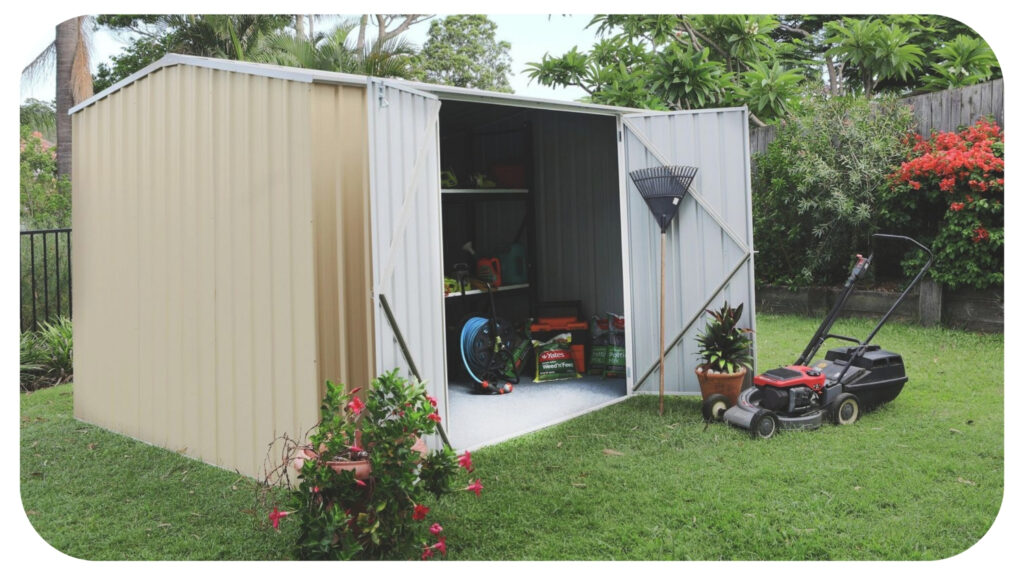Maximizing Your Outdoor Space: The Comprehensive Guide to Storage Sheds

Table of Contents:
- Choosing the Right Shed for Your Space
- Shed Materials and Durability
- Customization and Aesthetics
- Organizing Your Shed
- Security and Safety
- Zoning Laws and Permits
- Installation and Assembly
- Cost Considerations
- Eco-Friendly Practices
Key Takeaways
- Analyzing your backyard space and climate is critical when selecting a storage shed.
- Material choice, maintenance, and customization options greatly influence the functionality and appearance of your shed.
- Understanding local laws, securing permits, and considering the cost and environmental impact are essential for responsible ownership.
Choosing the Right Shed for Your Space
Embarking on the journey to enhance your backyard with a storage shed requires carefully considering your available outdoor space. A wisely chosen shed complements your garden without dominating it. The size and design should suit your landscape and blend with your property’s aesthetics. If your backyard is petite, compact Amish storage sheds can provide efficient solutions without cluttering the area. For homeowners living in regions that experience extreme weather conditions, selecting a shed built with suitable materials to withstand these challenges is critical for ensuring its longevity and protecting your stored items.
Shed Materials and Durability
Numerous materials are available for constructing storage sheds, each with pros and cons. While wooden sheds harmonize with garden settings and exude a timeless, inviting aesthetic, they require periodic painting or staining to preserve durability and visual appeal. Explore the materials used in constructing sheds, including those available from Amish storage sheds, to determine the best option for your needs. On the other hand, metal sheds provide robust durability and often come with a corrosion-resistant finish, making them a practical choice for regions with harsh weather. Plastic sheds are becoming increasingly popular due to their low maintenance demands, rot, pests, and rust resistance. Longevity and the required upkeep are two fundamental aspects to consider when choosing the best material for your storage shed.
Customization and Aesthetics
Personalizing your shed extends beyond functional considerations, creating visual harmony in your backyard. Many homeowners take pride in selecting colors, fixtures, and architectural details that complement their home and landscape design. Your shed can be a subtle addition to your yard or a visually striking focal point, with options ranging from slick modern finishes to rustic wooden textures. Incorporating window boxes, shutters, or even a small porch can elevate the simple storage shed into a charming garden feature. With thoughtful landscaping such as paths, flower beds, or climbing vines, the shed becomes an integrated part of your outdoor living space rather than a mere utility structure.
Organizing Your Shed
A well-organized shed transforms a dumping ground for garden tools and miscellaneous items into a functional storage system. Invest in quality shelving, hooks, and bins to store your tools and equipment systematically. By categorizing items and assigning them to designated spaces, you ensure they are easily accessible and protected from damage. Good lighting is another essential element that must be noticed in the shed organization; it ensures you can find what you need quickly, regardless of the time of day. A neat, orderly shed saves you time and effort and makes the space more inviting and usable.
Security and Safety
Your shed’s security should be paramount, especially if it shelters high-value items such as power tools, bicycles, or lawn equipment. Investing in a robust lock and door will deter theft and give you peace of mind. For enhanced security, some homeowners install motion sensor lights or even an alarm system to alert them of potential intruders. Regarding safety, ensure your shed is built on a firm, level foundation to prevent structural issues. Securely fastening shelves and ensuring a clear walkway inside the shed can minimize the risk of accidents, making your shed safer to use day-to-day.
Zoning Laws and Permits
Before breaking ground on a new shed, ensure you’re not breaking any laws. Zoning regulations and permit requirements are there to keep your community safe and orderly. Most municipalities have specific guidelines that dictate the size, location, and sometimes even the appearance of backyard structures. The proper permits may seem like a hassle, but avoiding future disputes or legal challenges is crucial. The process can be simplified with adequate research and understanding, as detailed in resources like What to Know About Shed Permits, which outlines the general process and importance of compliance with local building codes.
Installation and Assembly
Deciding whether to assemble your shed on your own or enlist the services of a professional often comes down to confidence in your DIY skills and the complexity of the shed’s design. Whatever path you choose, it’s important to anticipate potential obstacles such as leveling the ground, ensuring all pieces are correctly aligned, and that the doors and windows operate smoothly. Proper preparation, such as reading the instruction manual and having all the necessary tools, will pave the way for a smooth installation process.
Cost Considerations
The expenses related to owning a shed aren’t limited to the initial purchase price; they also encompass delivery, installation, and potential upkeep costs over the years. Remember to account for these additional costs while making your budget to obtain an accurate estimate of the whole cost. Although thriftiness is understandable, it shouldn’t come at the expense of quality. A well-built shed will require less maintenance and can even increase property value, making it a worthwhile investment in the long run.
Eco-Friendly Practices
Using eco-friendly methods will improve your storage shed’s longevity and efficiency while helping the environment. Using materials like recycled plastic and wood that are acquired responsibly decreases your storage solution’s environmental impact. Additionally, using solar panels for lighting or rainwater collection systems for maintenance can further decrease the shed’s ecological impact. An eco-conscious approach often results in a sturdier, more durable shed while simultaneously contributing to a greener planet.
Investing in a storage shed isn’t just throwing up an extra building on your property. It’s about designing a room that complements your lifestyle, raises the curb appeal of your garden, and increases the value of your house. Everything from the material selection to the accessorizing details plays a role in achieving this balance. The thorough Shed Buying Guide is a great place to start if you’re ready to learn about outdoor sheds’ latest practical improvements and design trends. It will help you choose the ideal storage option.
Recommended For You
What Is Cost of Penthouses In India?
Most Inside
Most Inside offers high-quality recommendations and valuable updates to enhance all aspects of your life, providing premium guidance and enriching experiences.




